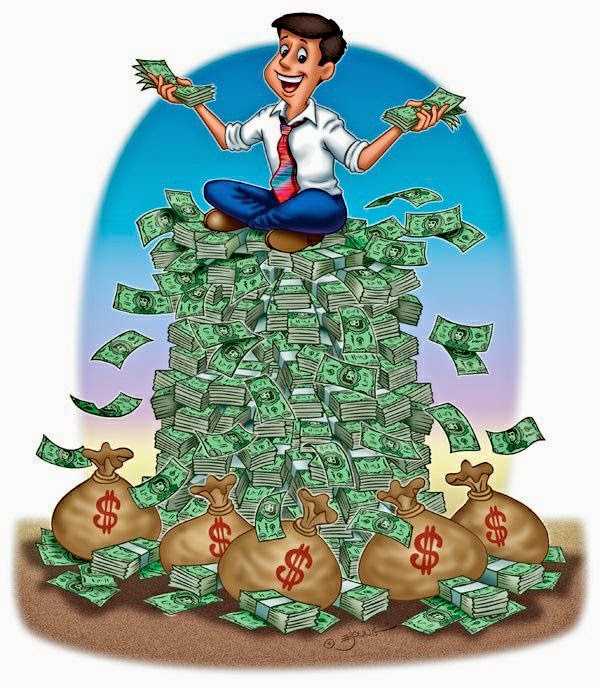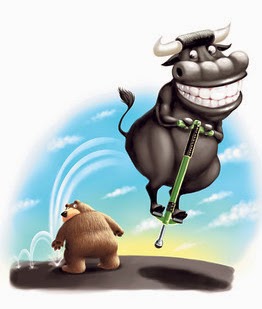Warren Buffett and Charlie Munger -- not to mention Berkshire
Hathaway itself -- so we'll be in Omaha, covering the event for Foolish
readers that can't make it out this year. In advance of the big day,
we'll be counting down on Fool.com with our annual "12 Days of
Berkshire" series.
Here are the 12 reasons why Warren Buffett is one of
the best investors of our time -- and how you can learn from him.
12. Warren Buffett knows how to hold stocks for the long term
What Warren does: Buffett knows the best investment wins come from owning great companies for long periods of time.
Consider
Wells Fargo (
NYSE: WFC )
, the bank that has become almost synonymous with Buffett and Berkshire
because it's Berkshire's largest stock position. Buffett started buying
Wells Fargo in 1989 and has owned it ever since. As of the end of 2013,
gains on that position alone had created more than $10 billion in value
for Berkshire shareholders.
What you can do: When you do your research and find a great
company to buy, be patient and let that company work on compounding your
investment over many years. With Wall Street so focused on very short
periods of time, there's more opportunity than ever to benefit from time arbitrage. If you have any doubt just contact with the
Stock Market Experts
11. Buffett owns up to his mistakes
What Warren does: Ego schmego, Buffett has no problem owning up to his mistakes.
Here's Buffett calling himself out in the most recent letter to Berkshire shareholders:
Most of you have never heard of Energy Future Holdings. Consider
yourselves lucky; I certainly wish I hadn't... About $2 billion of the
debt was purchased by Berkshire, pursuant to a decision I made without
consulting with Charlie. That was a big mistake. Unless natural gas
prices soar, EFH will almost certainly file for bankruptcy in 2014. Last
year, we sold our holdings for $259 million. While owning the bonds, we
received $837 million in cash interest. Overall, therefore, we suffered
a pre-tax loss of $873 million. Next time I'll call Charlie.
What you can do: Of course it sucks to make a mistake,
especially when it costs you money. But some of the best learning
opportunities in investing come by
learning from mistakes. So resist the
urge to sweep your whoopsies under the rug, and instead throw them
under the microscope to help you make a better decision the next time
around.
10. Buffett knows what he's good at... and leaves the rest to others
What Warren does: Buffett
is one savvy so-and-so when it comes to capital allocation -- that is,
knowing the best place to invest the cash that Berkshire businesses
earn. But Buffett hasn't developed any special knack for managing an
operating business.
So Buffett focuses his efforts on capital allocation and delegates
day-to-day operating decisions to the managers at the Berkshire
subsidiaries.
What you can do: Put in your time and efforts where you can
be most valuable. I believeindividual investors that have the talent and
interest can beat the market and earn a substantial return for their
time invested.
But if you're more dialed in to hand-weaving decorative baskets to
sell on Etsy, then you may be best off cashing in on your craftiness and
putting most of your
investing portfolio into low-cost index funds.
9. Buffett sticks to his circle of competence
What Warren does: Buffett
has spent his career developing an intimate knowledge of the finance
and consumer goods industries. This gives him an edge when investing in
these sectors. Berkshire's portfolio reflects the fact that Buffett
largely sticks to these core competencies -- the company's top five
holdings include Wells Fargo,
Coca-Cola (
NYSE: KO ) ,
American Express (
NYSE: AXP ) , and Munich Re.
What you can do: Don't expect that you're going to be an
expert in every industry. While diversification is good, you'll fare
better over the long run if you focus your investing in the industries
and types of companies that you understand the best.
8. Buffett puts his money where his best ideas are
What Warren does: At
the end of 2013, Berkshire Hathaway's stock portfolio was worth $117
billion. A full 55% of that $117 billion was invested in just four
stocks: Wells Fargo, Coca-Cola,
IBM (
NYSE: IBM ) , and American Express.
What you can do: Diversification is important, but if you
diversify too much, you end up owning a lot of companies that you don't
understand well or are able to fully follow. Diversify your portfolio,
but put more money behind your best ideas -- those ideas that you've
done the most work on, understand the best, and think have the most
long-term upside.
7. Buffett can clearly communicate his investing approach
What Warren does: Every year Buffett writes a letter
to Berkshire Hathaway's shareholders, sharing both details around
Berkshire's results as well as Buffett's deep thoughts on investing. The
annual letter is brilliant in the way it shares Buffett's thinking both
clearly and simply -- something that's rarely found among public
companies.
What you can do: Ask just about any behavioral finance expert
how you can improve your investing and you're likely to hear "Keep an
investing journal." Getting in the habit of clearly recording your
investing thinking -- the "whys" around your investments -- can go a
long way toward making you a better investor.
6. Buffett knows the best time to buy is... when nobody else is
What Warren does: One
of the classic Buffett saws is "Be fearful when others are greedy, and
be greedy when others are fearful." But it's more than just an overused
quote -- it's actually the way Buffett invests.
There's much proof of Buffett practicing what he preaches, but you needn't look further than the October 2008 op-ed he wrote in
The New York Times, "Buy American. I Am." October 2008 wasn't the bottom of the crash, but it was pretty dang close.
What you can do: In terms of replicating what Buffett does,
this may be the most difficult thing I've brought up thus far. The
psychological pull of the herd is incredibly powerful, and so doing the
exact opposite of what everyone else can be a Herculean task. But the
best buys you can make can be found when everybody else is pounding the
sell button.
5. Buffett knows what it means to be patient
What Warren does: Buffett
stockpiles cash. At the end of 2013, there was nearly $50 billion in
cash on Berkshire Hathaway's balance sheet. Buffett would rather have
much of that invested and working for investors, but he's willing to sit
on impressive amounts of cash until he can find an idea really worth
investing in.
What you can do: We're thinking long-term, so this isn't a
sprint, it's a marathon (if not an ultramarathon). If you're finding
great investment opportunities, by all means, invest in them. But don't
throw money at investments simply because you have the cash. Be willing
to sit on cash until you can put it into investments that are truly
worthwhile.
4. Buffett knows that you've got it easier than him
What Warren doesn't do: Buffett
doesn't spend much time investing in small companies. With a market
capitalization of more than $300 billion, investing in small companies
won't move the needle for Berkshire.
However, Buffett knows that some of the best returns are available in
smaller companies and to investors with far less capital than
Berkshire. Here's what Buffett's said:
It's a huge structural advantage not to have a lot of money.
I think I could make you 50% a year on $1 million. No, I know I could. I
guarantee that.
What you can do: Think small! In terms of growth
opportunity, it's not hard to realize that a $500 million company has a
lot more potential upside than a $100 billion company. That doesn't mean
small companies will automatically succeed -- many, in fact, fail
miserably. But a well-chosen small company can obliterate the returns of
a plodding large cap.
3. Buffett learns from others
What Warren does: Buffett's
investing career began in value-investing guru Benjamin Graham's
classroom. As a voracious reader, Buffett continued to learn from many
other investing luminaries, Phil Fisher not least among them. Buffett has also learned an enormous amount from his partner-in-crime Charlie Munger.
What you can do: Humility can go a long way when it
comes to investing. Being a lifetime learner and staying open-minded
can help you continue to grow as an investor. There are lots of great
books on investing -- from Ben Graham's
Intelligent Investor to Peter Lynch's
One Up On Wall Street
-- but your investing can improve from insights in many other fields
from business and psychology to computer science and physics.
2. Buffett doesn't get hung up on stock market forecasts
What Warren does: In
short, he ignores the oodles of short-term market predictions. In fact,
he put it much more forcefully in his 1992 letter to shareholders;
We've long felt that the only value of stock forecasters is to make
fortune tellers look good. Even now, Charlie and I continue to believe
that short-term market forecasts are poison and should be kept locked up
in a safe place, away from children and also from grown-ups who behave
in the market like children.
What you can do: Follow Buffett's lead and ignore short-term
market forecasts. These one-year market guesses are so prevalent
because news outlets think they draw viewers and readers -- sadly, they
do -- and because the forecasters themselves bear little risk -- if they
get it right, they'll be hailed as a genius, while if they get it
wrong, nobody will even remember.
1. Buffett maintains a healthy diet
What Warren does: Ok,
I'm kidding. Even though Buffett has reached the impressive age of 83,
it's no secret that he doesn't take great care of himself. Buffett is
known for his love of cheeseburgers and Cherry Cokes, and during the
annual Berkshire Hathaway shareholder meeting he does impressive work on
an array of See's Candies (mostly the ridiculously delicious peanut
brittle).
What you can do: Warren Buffett is a great investor, but
maybe we don't have to copy everything he does. But then again, maybe
cheeseburgers and Cherry Cokes are a key contributor of his success.
Perhaps we need to do some more research...
The greatest thing Warren Buffett ever said
Warren
Buffett has made billions through his investing and he wants you to be
able to invest like him. Through the years, Buffett has offered up
investing tips to shareholders of Berkshire Hathaway.
To increase your trading profit you need to change your trading techniques as well. No a days technology is very helpful for stock traders and there are so many trading systems are present in the market to increase your trading profit.
Online Robotic Stock Trader is one of the best trading system of 2014. This system is design to avoid the loss from your stock trading and also provide you regular profit.
If you have any query related with stock trading or you want to take expert guidance just fill this simple Form or Visit
http://onlineroboticstocktrader.com/contact-us/









































